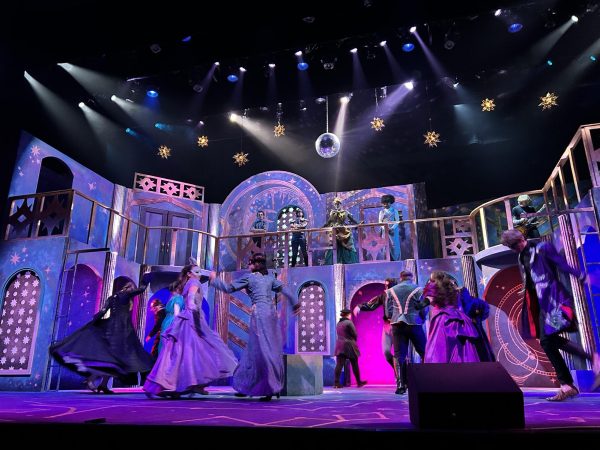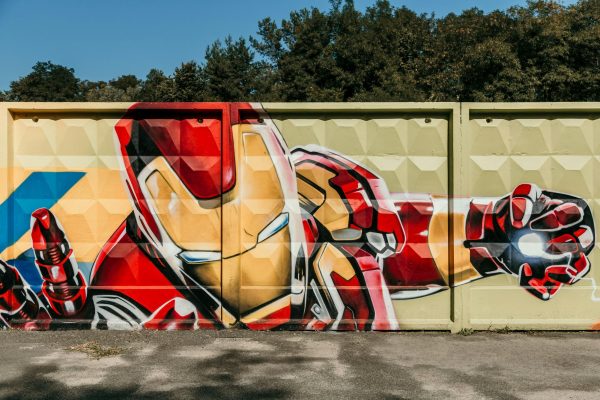CAB Art Gallery welcomes new programs and patrons
In late October, in a near 600-square-foot room, 78 pieces of drawings, paintings and other works displayed the talent of six artists who recreated scenes from the North Carolina Zoo. In this room—the CAB Art Gallery, UNC Wilmington’s creative writing department chair, Michael White, read from his most recent collection of poetry, “Vermeer in Hell.” There, White shared the story of his travels to Dresden, Germany to view and write about many art pieces by the 17th century Dutch painter, Johannes Vermeer.
White discussed paintings and poetry with his audience—made of local community members and both art and writing students and faculty—while vivid 2-D depictions of hippopotamuses and giraffes surrounded him and a small podium. He shared his methods, successes and struggles as everyone shared the unique venue.
This was the first faculty reading at the CAB Art Gallery, named for the space where it’s located, the Cultural Arts Building—UNCW’s educational space for music, theatre and art. At this event, newly appointed gallery director and studio art professor Aaron Wilcox expressed his desire to incorporate literature and music in the small gallery space.
“When Michael has a poetry reading in an art gallery, that changes the whole nature of the reading, and it changes the nature of the gallery, and it changes the nature of the art,” Wilcox said two days after the event. “So you’re interacting with the work in almost a more passive way. It’s around you, but you’re not seeking it out, so I think you can absorb it a little bit differently, and I think it actually can create almost a deeper appreciation.”
Thinking about these aspects—art, literature and music—Wilcox wants to highlight what he calls the three pillars of the American experience.
“We have the art component, but it’s made richer and more interesting if we can get all three of those combined,” he said. “I want to keep everything in context, and I think with the other two we can develop that context a little bit more clearly.”
This cross-educational interest inspired Wilcox to initiate several new programs and other out-of-the-box events only months into his first year as director. Although he’s motivated by these three pillars, event plans expanded beyond artistic themes. By December, the CAB Art Gallery will have been visited by a writer, several groups of young children, a marine biologist, a surfing club, a psychology professor, a collection of jazz performers and varieties of patrons. After all, that’s Wilcox’s ultimate goal—to have the gallery “talked about” by all sorts of attendees.
“It’s more than just coming in and looking at the work,” he said. “In order to really appreciate it and understand it, you have to talk about it [and] come at it from a variety of perspectives and a variety of different angles.”
The creation of CAB
Music, theater and arts education used to be housed across the UNCW campus in Kenan Hall, now the creative writing department building. At that time, the building lobby (with two display cases) acted has the only gallery space.
Then, in 2007, cultural arts moved into a larger building with two galleries and several performance spaces. Wilcox said he’s been teaching at UNCW since 1998.
“We were trying to make it a little bit nicer, a little bit… cleaner and efficient, so it was more a destination then a pass-through place,” Wilcox said of the CAB Art Gallery.
Each exhibit may last about three to four weeks. The first recorded exhibition in the new gallery space, located on the first floor of the building, was a faculty art show, which appeared in 2007, according to the department. Ten faculty members, including Wilcox, shared their work in the gallery for the first time.
Current art and art history department chair Amy Kirschke explained that, at the time of CAB’s creation, previous professor Carlton Wilkinson acted as the gallery director until 2010. In particular, Kirschke remembered an exhibit of African American art that Wilkinson authored and curated. Also under Wilkinson’s leadership, students helped artist Jairo Prado create an interactive wall piece that still resides on display in the building today.
Then, from 2011 until the summer of this year, photography professor Courtney Johnson managed gallery events and conducted exhibitions.
Studio art professor Anne Lindberg, who currently serves on the gallery committee, recalled one of Johnson’s exhibitions.
“Before I even arrived at UNCW, I saw an exhibition curated by professor Johnson, the previous gallery director, of a young painter named Kajahl Benes,” she said. “I thought the show was really fresh, and it was just fantastic to see these big, colorful, thoughtful paintings… All of the exhibitions I have seen at the gallery have been smartly curated and well-conceived.”
Other gallery attendees may also remember Johnson’s Light Lure exhibit and other faculty shows during her directorship.
Though students and faculty admired many gallery events, in general, the CAB Art Gallery only held an opening event and sometimes a closing reception and maybe one other activity during each exhibition, Wilcox and Kirschke explained.
Increasing attendance at CAB
In addition to unique events like the White reading, the gallery now hosts a regular programs. For example, Wilcox initiated a series of Sunday Connections, which happens on the last Sunday of each exhibit.
“I bring in colleagues or faculty members or experts who have a tangential relationship to the work in the exhibition,” Wilcox said. “I ask them to come in and talk about the work they do for about 15 minutes… I don’t want them to make the connection to the artwork, I want the patrons to make the connection to create dialogue so we can demonstrate relevance.”
For the first opening exhibit of the 2014-2015 school year, California-based artist Russell Crotty shared his surf drawings, surf and map books, surf sequence panels and other works in a collection called “Surf Works.” During this show, Paul Hosier, professor emeritus from biology and marine biology, presented his research on Sept. 28, the first Sunday Connection. In addition, UNCW Surf Club and Surfrider Foundation watched “180° South” after gathering in the gallery to view Crotty’s art.
Since adding events like this, Wilcox feels attendance has increased.
A Pew Research study from September of this year found that “younger Americans under 30 attend sporting events regularly, and 36 percent attend concerts, plays or dance performances. Some 32 percent visit bookstores regularly, and 26 percent visit museums, art galleries or historical sites.”
According to this, the gallery isn’t competing with the great odds. Of these activities, students are least likely to attend art galleries. Despite this, Wilcox said the recent gallery events have received greater responses.
Though numbers haven’t been recorded for the gallery before, he and assistant director/alumni Topher Alexander began tracking the number of patrons who attend. According to the numbers collected, the Crotty exhibit brought in nearly 400 unique visitors during the course of its exhibit.
The “Zoo Scenes Artist Group” show (in progress) gathered about 110 patrons just for the opening reception and about 20 more for the White reading.
“It makes it such a well-rounded experience,” Alexander said in reference to the new programming. “To get input from people around campus, it’s sometimes better than the input [art students] have on it. It’s a really fresh outlook.”
Creating community connections
Both Alexander and gallery committee member Pam Toll, a studio art professor, said they feel isolated in the Cultural Arts Building on campus.
“We’re so busy in our departments,” she said. “You get so caught up in your work that you can’t get your of your nest.”
Toll has two sons—a poet and a musician, so she understands correlation that initially inspired Wilcox’s hope for program expansion, but she appreciates his ability to tap into community connections as well.
For example, a group of fourth grade girls from a potential charter school called the Young Women’s Leadership Academy visited the gallery to participate in several mini-activates like drawing sculptures and writing a haiku on Oct. 25.
“The gallery has taken on a new level of community,” director Kirschke said. “[Wilcox] has created programs that don’t just bring students and the UNCW community. He’s created programs that bring in the greater Wilmington area—all ages.”
Normally, the gallery is open Monday through Thursday, 12 to 5 p.m. Now, Kirschke noted, people who may not be able to attend during those hours can see the art at other times.
“I feel like it’s a lot more alive,” she said. “Our campus is the center of contemporary art here. We need to bring our community to see what we’re doing and have more interaction.”
Benefitting the students
Though more events have begun, the gallery’s initial purpose remains—to serve the students. For example, assistant/alumni Alexander said most of the students he knows who participated at the gallery, in some way, moved on to do similar work.
The next show, the annual “Senior Exhibit,” begins on Nov. 20.
“The first interaction [students] have with gallery work is our gallery,” Kirschke said. “The seniors are really involved in the hanging of the fall senior show.”
And in general, art students learn from visiting artists who often give talks at their opening receptions.
“I have the artist talk and we engage the patrons and the artist,” Wilcox said. “It’s one thing to just go look at it, but then to be able to associate with the person who made it—that’s another thing.”
With these traditional values and new developments, Kirschke suggested that the art department may have out-grown their building’s gallery space. She said that Dean Aswani Volety of the College of Arts and Sciences has expressed interest in increasing their gallery space for even more interaction and creative events.
For now, though, Wilcox, his committee and his assistants will continue planning traditional events and new ones with connections to literature or music or science and many other communities.









